Organizational Behavior Analysis of Sainsbury's: Unit 12 Report
VerifiedAdded on 2021/02/22
|12
|3712
|76
Report
AI Summary
This report provides an in-depth analysis of organizational behavior, focusing on Sainsbury's as a case study. It explores key concepts such as organizational culture, power dynamics (including the application of the Rawen French Model), and politics, examining their impact on individual and team performance. The report delves into motivational theories, including Maslow's Hierarchy of Needs, Herzberg's Two-Factor Theory, Vroom's Expectancy Theory, and Adams' Equity Theory, offering recommendations for their practical application. Furthermore, the report contrasts effective and ineffective team characteristics, referencing Tuckman's stages of team development and Belbin's team roles. The analysis culminates in practical recommendations for improving Sainsbury's organizational effectiveness, including suggestions for leadership approaches and cultural strategies.
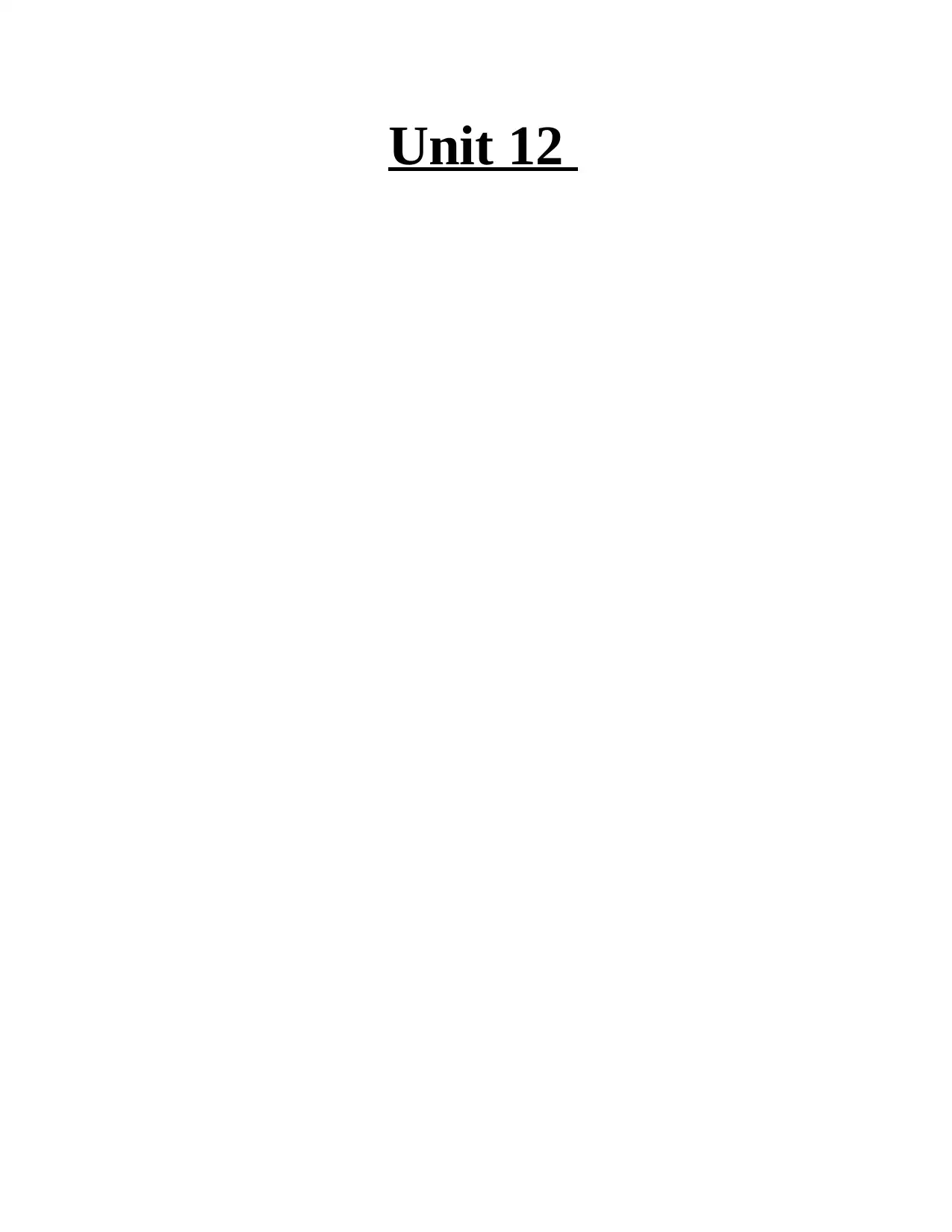
Unit 12
Paraphrase This Document
Need a fresh take? Get an instant paraphrase of this document with our AI Paraphraser
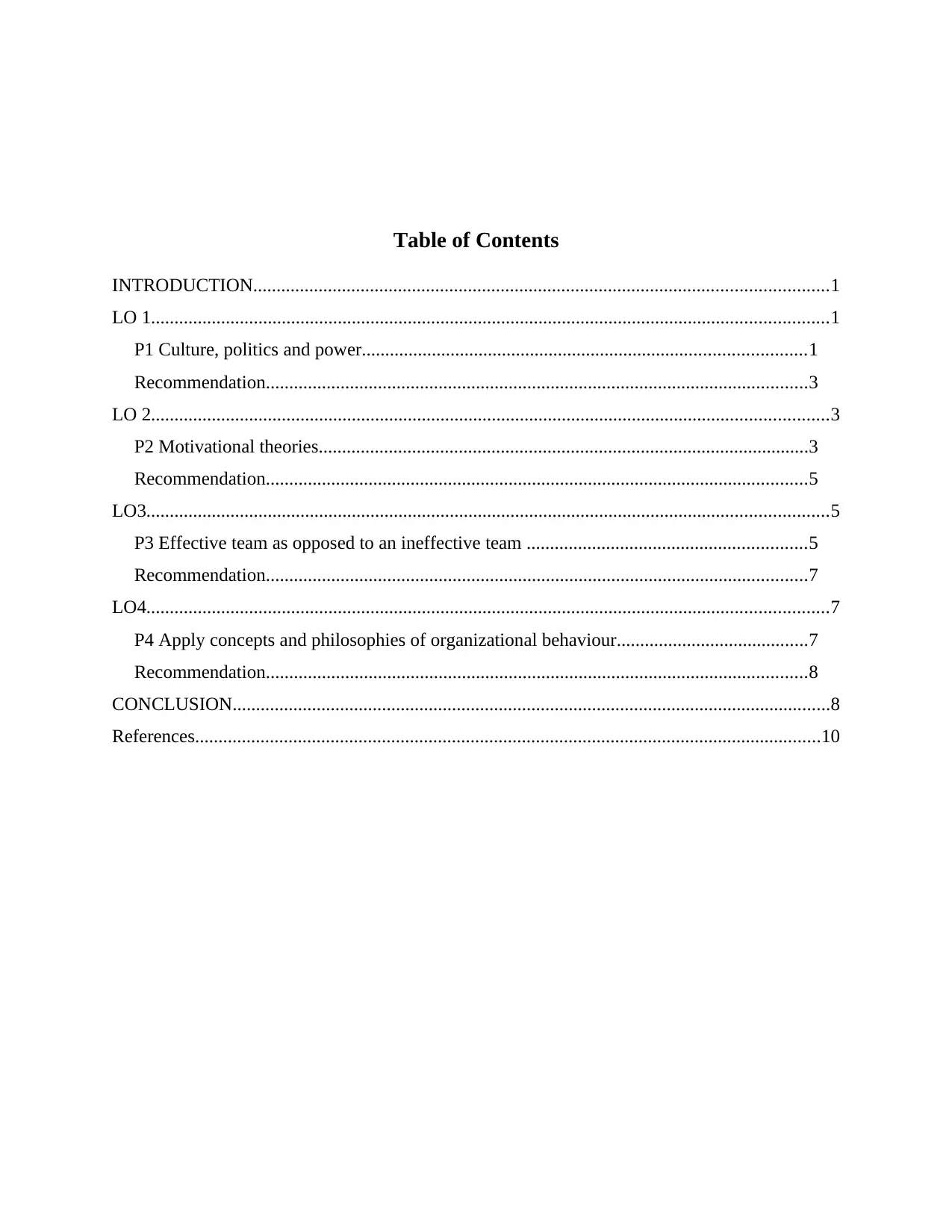
Table of Contents
INTRODUCTION...........................................................................................................................1
LO 1.................................................................................................................................................1
P1 Culture, politics and power...............................................................................................1
Recommendation....................................................................................................................3
LO 2.................................................................................................................................................3
P2 Motivational theories.........................................................................................................3
Recommendation....................................................................................................................5
LO3..................................................................................................................................................5
P3 Effective team as opposed to an ineffective team ............................................................5
Recommendation....................................................................................................................7
LO4..................................................................................................................................................7
P4 Apply concepts and philosophies of organizational behaviour.........................................7
Recommendation....................................................................................................................8
CONCLUSION................................................................................................................................8
References......................................................................................................................................10
INTRODUCTION...........................................................................................................................1
LO 1.................................................................................................................................................1
P1 Culture, politics and power...............................................................................................1
Recommendation....................................................................................................................3
LO 2.................................................................................................................................................3
P2 Motivational theories.........................................................................................................3
Recommendation....................................................................................................................5
LO3..................................................................................................................................................5
P3 Effective team as opposed to an ineffective team ............................................................5
Recommendation....................................................................................................................7
LO4..................................................................................................................................................7
P4 Apply concepts and philosophies of organizational behaviour.........................................7
Recommendation....................................................................................................................8
CONCLUSION................................................................................................................................8
References......................................................................................................................................10

⊘ This is a preview!⊘
Do you want full access?
Subscribe today to unlock all pages.

Trusted by 1+ million students worldwide
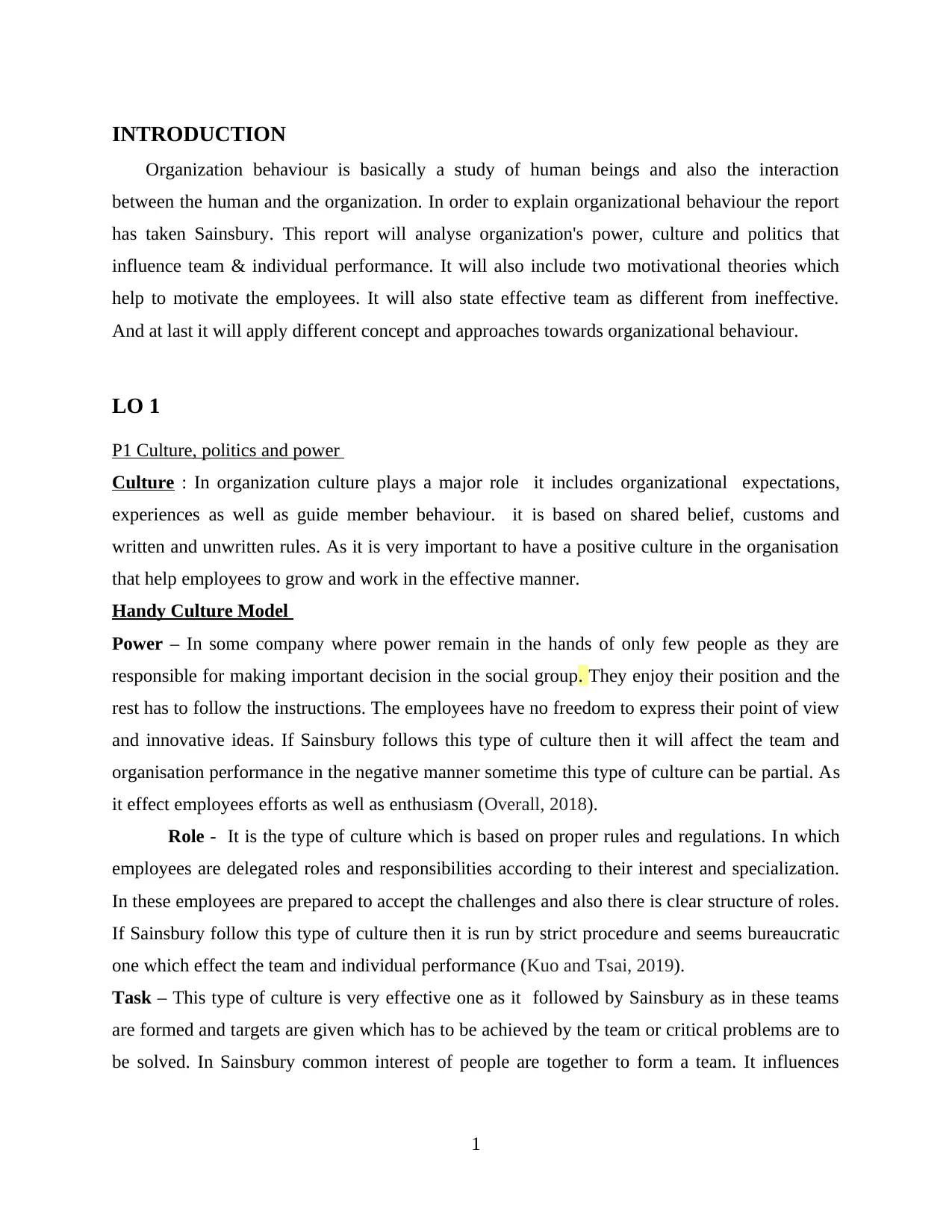
INTRODUCTION
Organization behaviour is basically a study of human beings and also the interaction
between the human and the organization. In order to explain organizational behaviour the report
has taken Sainsbury. This report will analyse organization's power, culture and politics that
influence team & individual performance. It will also include two motivational theories which
help to motivate the employees. It will also state effective team as different from ineffective.
And at last it will apply different concept and approaches towards organizational behaviour.
LO 1
P1 Culture, politics and power
Culture : In organization culture plays a major role it includes organizational expectations,
experiences as well as guide member behaviour. it is based on shared belief, customs and
written and unwritten rules. As it is very important to have a positive culture in the organisation
that help employees to grow and work in the effective manner.
Handy Culture Model
Power – In some company where power remain in the hands of only few people as they are
responsible for making important decision in the social group. They enjoy their position and the
rest has to follow the instructions. The employees have no freedom to express their point of view
and innovative ideas. If Sainsbury follows this type of culture then it will affect the team and
organisation performance in the negative manner sometime this type of culture can be partial. As
it effect employees efforts as well as enthusiasm (Overall, 2018).
Role - It is the type of culture which is based on proper rules and regulations. In which
employees are delegated roles and responsibilities according to their interest and specialization.
In these employees are prepared to accept the challenges and also there is clear structure of roles.
If Sainsbury follow this type of culture then it is run by strict procedure and seems bureaucratic
one which effect the team and individual performance (Kuo and Tsai, 2019).
Task – This type of culture is very effective one as it followed by Sainsbury as in these teams
are formed and targets are given which has to be achieved by the team or critical problems are to
be solved. In Sainsbury common interest of people are together to form a team. It influences
1
Organization behaviour is basically a study of human beings and also the interaction
between the human and the organization. In order to explain organizational behaviour the report
has taken Sainsbury. This report will analyse organization's power, culture and politics that
influence team & individual performance. It will also include two motivational theories which
help to motivate the employees. It will also state effective team as different from ineffective.
And at last it will apply different concept and approaches towards organizational behaviour.
LO 1
P1 Culture, politics and power
Culture : In organization culture plays a major role it includes organizational expectations,
experiences as well as guide member behaviour. it is based on shared belief, customs and
written and unwritten rules. As it is very important to have a positive culture in the organisation
that help employees to grow and work in the effective manner.
Handy Culture Model
Power – In some company where power remain in the hands of only few people as they are
responsible for making important decision in the social group. They enjoy their position and the
rest has to follow the instructions. The employees have no freedom to express their point of view
and innovative ideas. If Sainsbury follows this type of culture then it will affect the team and
organisation performance in the negative manner sometime this type of culture can be partial. As
it effect employees efforts as well as enthusiasm (Overall, 2018).
Role - It is the type of culture which is based on proper rules and regulations. In which
employees are delegated roles and responsibilities according to their interest and specialization.
In these employees are prepared to accept the challenges and also there is clear structure of roles.
If Sainsbury follow this type of culture then it is run by strict procedure and seems bureaucratic
one which effect the team and individual performance (Kuo and Tsai, 2019).
Task – This type of culture is very effective one as it followed by Sainsbury as in these teams
are formed and targets are given which has to be achieved by the team or critical problems are to
be solved. In Sainsbury common interest of people are together to form a team. It influences
1
Paraphrase This Document
Need a fresh take? Get an instant paraphrase of this document with our AI Paraphraser
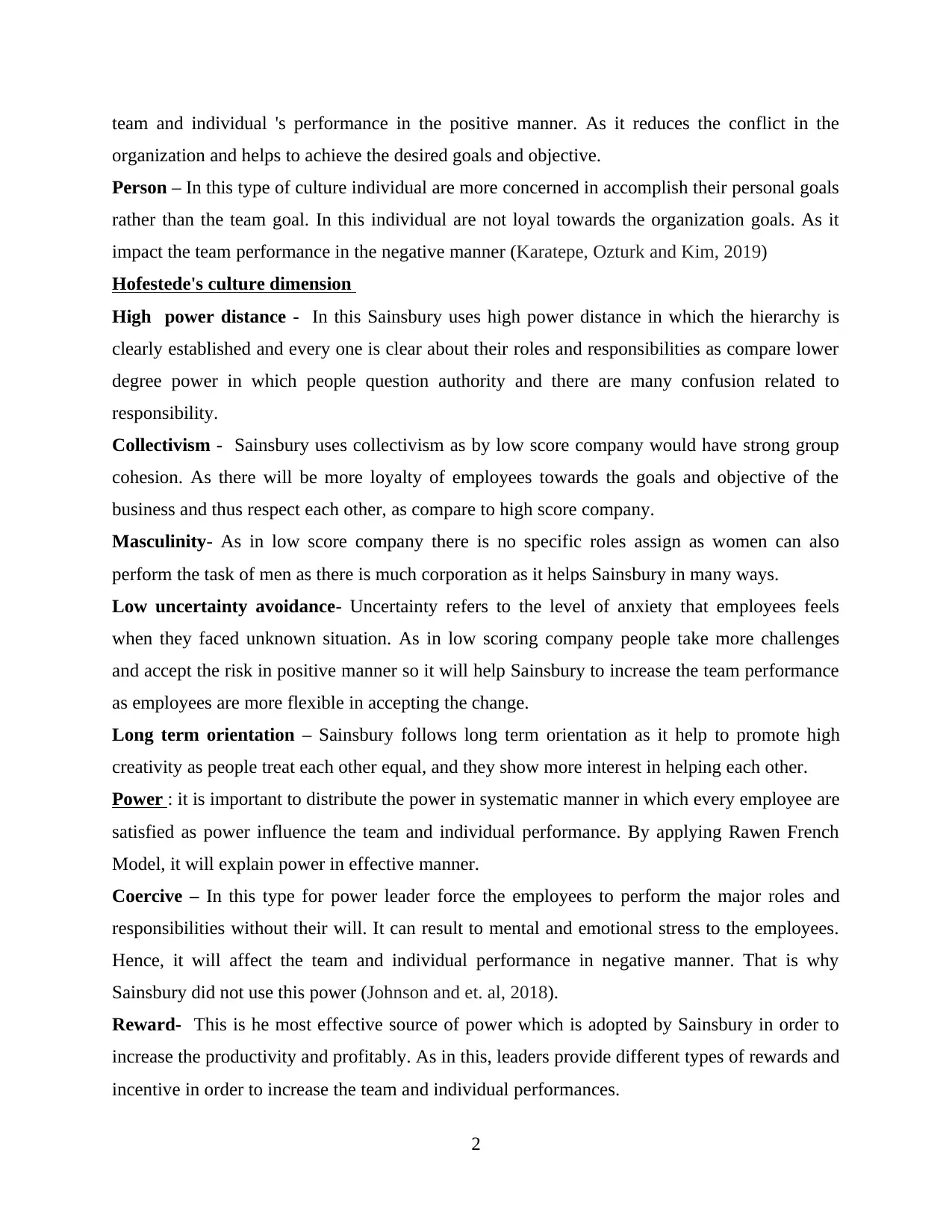
team and individual 's performance in the positive manner. As it reduces the conflict in the
organization and helps to achieve the desired goals and objective.
Person – In this type of culture individual are more concerned in accomplish their personal goals
rather than the team goal. In this individual are not loyal towards the organization goals. As it
impact the team performance in the negative manner (Karatepe, Ozturk and Kim, 2019)
Hofestede's culture dimension
High power distance - In this Sainsbury uses high power distance in which the hierarchy is
clearly established and every one is clear about their roles and responsibilities as compare lower
degree power in which people question authority and there are many confusion related to
responsibility.
Collectivism - Sainsbury uses collectivism as by low score company would have strong group
cohesion. As there will be more loyalty of employees towards the goals and objective of the
business and thus respect each other, as compare to high score company.
Masculinity- As in low score company there is no specific roles assign as women can also
perform the task of men as there is much corporation as it helps Sainsbury in many ways.
Low uncertainty avoidance- Uncertainty refers to the level of anxiety that employees feels
when they faced unknown situation. As in low scoring company people take more challenges
and accept the risk in positive manner so it will help Sainsbury to increase the team performance
as employees are more flexible in accepting the change.
Long term orientation – Sainsbury follows long term orientation as it help to promote high
creativity as people treat each other equal, and they show more interest in helping each other.
Power : it is important to distribute the power in systematic manner in which every employee are
satisfied as power influence the team and individual performance. By applying Rawen French
Model, it will explain power in effective manner.
Coercive – In this type for power leader force the employees to perform the major roles and
responsibilities without their will. It can result to mental and emotional stress to the employees.
Hence, it will affect the team and individual performance in negative manner. That is why
Sainsbury did not use this power (Johnson and et. al, 2018).
Reward- This is he most effective source of power which is adopted by Sainsbury in order to
increase the productivity and profitably. As in this, leaders provide different types of rewards and
incentive in order to increase the team and individual performances.
2
organization and helps to achieve the desired goals and objective.
Person – In this type of culture individual are more concerned in accomplish their personal goals
rather than the team goal. In this individual are not loyal towards the organization goals. As it
impact the team performance in the negative manner (Karatepe, Ozturk and Kim, 2019)
Hofestede's culture dimension
High power distance - In this Sainsbury uses high power distance in which the hierarchy is
clearly established and every one is clear about their roles and responsibilities as compare lower
degree power in which people question authority and there are many confusion related to
responsibility.
Collectivism - Sainsbury uses collectivism as by low score company would have strong group
cohesion. As there will be more loyalty of employees towards the goals and objective of the
business and thus respect each other, as compare to high score company.
Masculinity- As in low score company there is no specific roles assign as women can also
perform the task of men as there is much corporation as it helps Sainsbury in many ways.
Low uncertainty avoidance- Uncertainty refers to the level of anxiety that employees feels
when they faced unknown situation. As in low scoring company people take more challenges
and accept the risk in positive manner so it will help Sainsbury to increase the team performance
as employees are more flexible in accepting the change.
Long term orientation – Sainsbury follows long term orientation as it help to promote high
creativity as people treat each other equal, and they show more interest in helping each other.
Power : it is important to distribute the power in systematic manner in which every employee are
satisfied as power influence the team and individual performance. By applying Rawen French
Model, it will explain power in effective manner.
Coercive – In this type for power leader force the employees to perform the major roles and
responsibilities without their will. It can result to mental and emotional stress to the employees.
Hence, it will affect the team and individual performance in negative manner. That is why
Sainsbury did not use this power (Johnson and et. al, 2018).
Reward- This is he most effective source of power which is adopted by Sainsbury in order to
increase the productivity and profitably. As in this, leaders provide different types of rewards and
incentive in order to increase the team and individual performances.
2
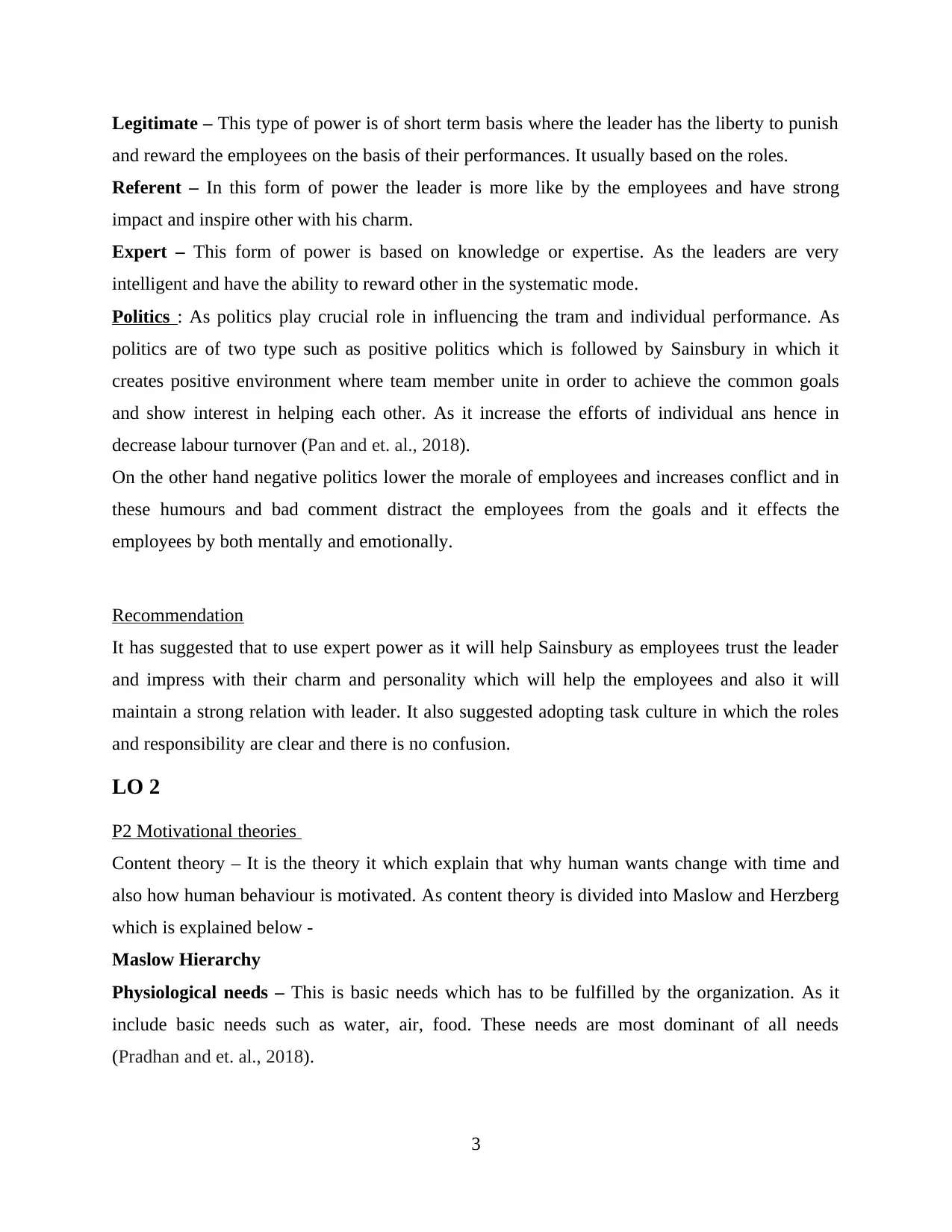
Legitimate – This type of power is of short term basis where the leader has the liberty to punish
and reward the employees on the basis of their performances. It usually based on the roles.
Referent – In this form of power the leader is more like by the employees and have strong
impact and inspire other with his charm.
Expert – This form of power is based on knowledge or expertise. As the leaders are very
intelligent and have the ability to reward other in the systematic mode.
Politics : As politics play crucial role in influencing the tram and individual performance. As
politics are of two type such as positive politics which is followed by Sainsbury in which it
creates positive environment where team member unite in order to achieve the common goals
and show interest in helping each other. As it increase the efforts of individual ans hence in
decrease labour turnover (Pan and et. al., 2018).
On the other hand negative politics lower the morale of employees and increases conflict and in
these humours and bad comment distract the employees from the goals and it effects the
employees by both mentally and emotionally.
Recommendation
It has suggested that to use expert power as it will help Sainsbury as employees trust the leader
and impress with their charm and personality which will help the employees and also it will
maintain a strong relation with leader. It also suggested adopting task culture in which the roles
and responsibility are clear and there is no confusion.
LO 2
P2 Motivational theories
Content theory – It is the theory it which explain that why human wants change with time and
also how human behaviour is motivated. As content theory is divided into Maslow and Herzberg
which is explained below -
Maslow Hierarchy
Physiological needs – This is basic needs which has to be fulfilled by the organization. As it
include basic needs such as water, air, food. These needs are most dominant of all needs
(Pradhan and et. al., 2018).
3
and reward the employees on the basis of their performances. It usually based on the roles.
Referent – In this form of power the leader is more like by the employees and have strong
impact and inspire other with his charm.
Expert – This form of power is based on knowledge or expertise. As the leaders are very
intelligent and have the ability to reward other in the systematic mode.
Politics : As politics play crucial role in influencing the tram and individual performance. As
politics are of two type such as positive politics which is followed by Sainsbury in which it
creates positive environment where team member unite in order to achieve the common goals
and show interest in helping each other. As it increase the efforts of individual ans hence in
decrease labour turnover (Pan and et. al., 2018).
On the other hand negative politics lower the morale of employees and increases conflict and in
these humours and bad comment distract the employees from the goals and it effects the
employees by both mentally and emotionally.
Recommendation
It has suggested that to use expert power as it will help Sainsbury as employees trust the leader
and impress with their charm and personality which will help the employees and also it will
maintain a strong relation with leader. It also suggested adopting task culture in which the roles
and responsibility are clear and there is no confusion.
LO 2
P2 Motivational theories
Content theory – It is the theory it which explain that why human wants change with time and
also how human behaviour is motivated. As content theory is divided into Maslow and Herzberg
which is explained below -
Maslow Hierarchy
Physiological needs – This is basic needs which has to be fulfilled by the organization. As it
include basic needs such as water, air, food. These needs are most dominant of all needs
(Pradhan and et. al., 2018).
3
⊘ This is a preview!⊘
Do you want full access?
Subscribe today to unlock all pages.

Trusted by 1+ million students worldwide
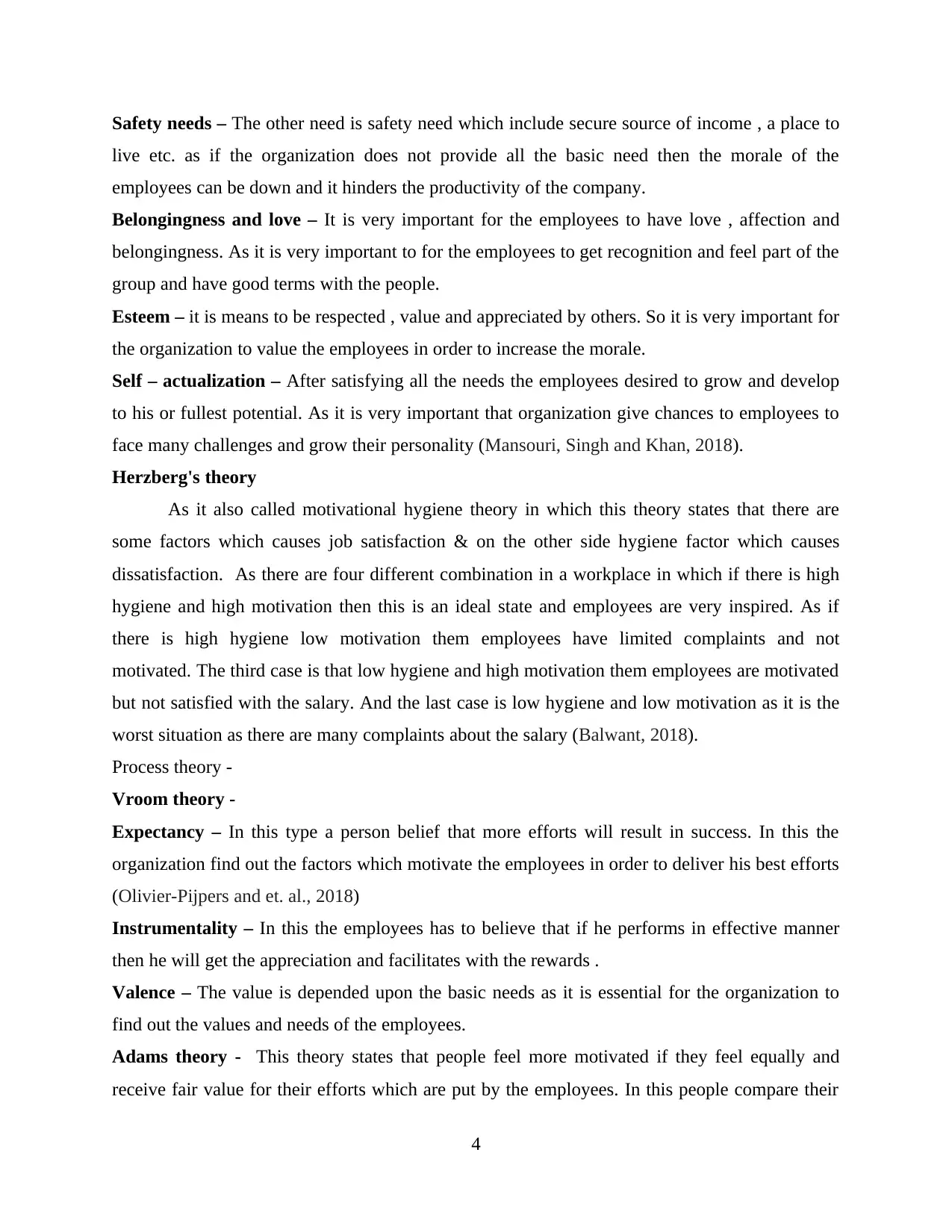
Safety needs – The other need is safety need which include secure source of income , a place to
live etc. as if the organization does not provide all the basic need then the morale of the
employees can be down and it hinders the productivity of the company.
Belongingness and love – It is very important for the employees to have love , affection and
belongingness. As it is very important to for the employees to get recognition and feel part of the
group and have good terms with the people.
Esteem – it is means to be respected , value and appreciated by others. So it is very important for
the organization to value the employees in order to increase the morale.
Self – actualization – After satisfying all the needs the employees desired to grow and develop
to his or fullest potential. As it is very important that organization give chances to employees to
face many challenges and grow their personality (Mansouri, Singh and Khan, 2018).
Herzberg's theory
As it also called motivational hygiene theory in which this theory states that there are
some factors which causes job satisfaction & on the other side hygiene factor which causes
dissatisfaction. As there are four different combination in a workplace in which if there is high
hygiene and high motivation then this is an ideal state and employees are very inspired. As if
there is high hygiene low motivation them employees have limited complaints and not
motivated. The third case is that low hygiene and high motivation them employees are motivated
but not satisfied with the salary. And the last case is low hygiene and low motivation as it is the
worst situation as there are many complaints about the salary (Balwant, 2018).
Process theory -
Vroom theory -
Expectancy – In this type a person belief that more efforts will result in success. In this the
organization find out the factors which motivate the employees in order to deliver his best efforts
(Olivier-Pijpers and et. al., 2018)
Instrumentality – In this the employees has to believe that if he performs in effective manner
then he will get the appreciation and facilitates with the rewards .
Valence – The value is depended upon the basic needs as it is essential for the organization to
find out the values and needs of the employees.
Adams theory - This theory states that people feel more motivated if they feel equally and
receive fair value for their efforts which are put by the employees. In this people compare their
4
live etc. as if the organization does not provide all the basic need then the morale of the
employees can be down and it hinders the productivity of the company.
Belongingness and love – It is very important for the employees to have love , affection and
belongingness. As it is very important to for the employees to get recognition and feel part of the
group and have good terms with the people.
Esteem – it is means to be respected , value and appreciated by others. So it is very important for
the organization to value the employees in order to increase the morale.
Self – actualization – After satisfying all the needs the employees desired to grow and develop
to his or fullest potential. As it is very important that organization give chances to employees to
face many challenges and grow their personality (Mansouri, Singh and Khan, 2018).
Herzberg's theory
As it also called motivational hygiene theory in which this theory states that there are
some factors which causes job satisfaction & on the other side hygiene factor which causes
dissatisfaction. As there are four different combination in a workplace in which if there is high
hygiene and high motivation then this is an ideal state and employees are very inspired. As if
there is high hygiene low motivation them employees have limited complaints and not
motivated. The third case is that low hygiene and high motivation them employees are motivated
but not satisfied with the salary. And the last case is low hygiene and low motivation as it is the
worst situation as there are many complaints about the salary (Balwant, 2018).
Process theory -
Vroom theory -
Expectancy – In this type a person belief that more efforts will result in success. In this the
organization find out the factors which motivate the employees in order to deliver his best efforts
(Olivier-Pijpers and et. al., 2018)
Instrumentality – In this the employees has to believe that if he performs in effective manner
then he will get the appreciation and facilitates with the rewards .
Valence – The value is depended upon the basic needs as it is essential for the organization to
find out the values and needs of the employees.
Adams theory - This theory states that people feel more motivated if they feel equally and
receive fair value for their efforts which are put by the employees. In this people compare their
4
Paraphrase This Document
Need a fresh take? Get an instant paraphrase of this document with our AI Paraphraser
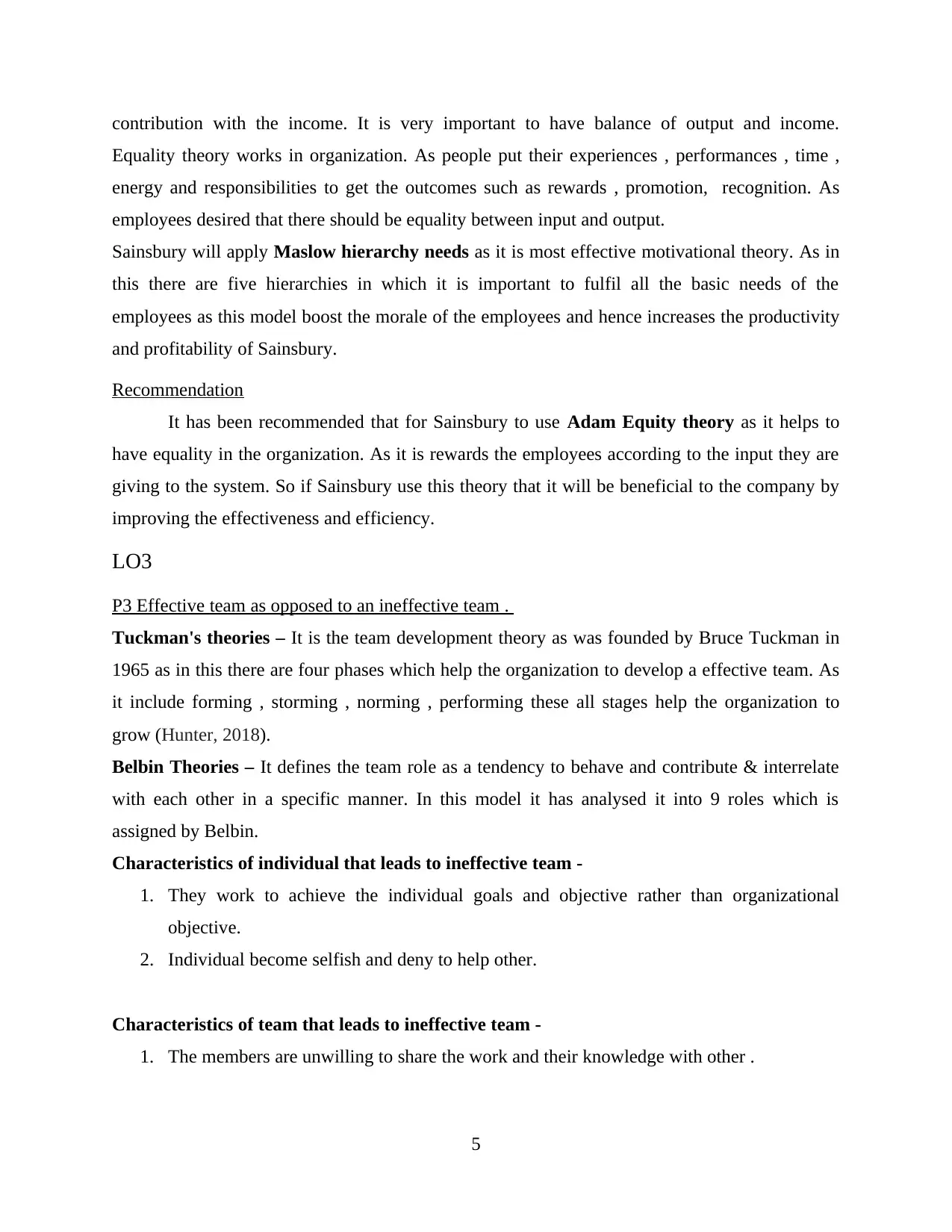
contribution with the income. It is very important to have balance of output and income.
Equality theory works in organization. As people put their experiences , performances , time ,
energy and responsibilities to get the outcomes such as rewards , promotion, recognition. As
employees desired that there should be equality between input and output.
Sainsbury will apply Maslow hierarchy needs as it is most effective motivational theory. As in
this there are five hierarchies in which it is important to fulfil all the basic needs of the
employees as this model boost the morale of the employees and hence increases the productivity
and profitability of Sainsbury.
Recommendation
It has been recommended that for Sainsbury to use Adam Equity theory as it helps to
have equality in the organization. As it is rewards the employees according to the input they are
giving to the system. So if Sainsbury use this theory that it will be beneficial to the company by
improving the effectiveness and efficiency.
LO3
P3 Effective team as opposed to an ineffective team .
Tuckman's theories – It is the team development theory as was founded by Bruce Tuckman in
1965 as in this there are four phases which help the organization to develop a effective team. As
it include forming , storming , norming , performing these all stages help the organization to
grow (Hunter, 2018).
Belbin Theories – It defines the team role as a tendency to behave and contribute & interrelate
with each other in a specific manner. In this model it has analysed it into 9 roles which is
assigned by Belbin.
Characteristics of individual that leads to ineffective team -
1. They work to achieve the individual goals and objective rather than organizational
objective.
2. Individual become selfish and deny to help other.
Characteristics of team that leads to ineffective team -
1. The members are unwilling to share the work and their knowledge with other .
5
Equality theory works in organization. As people put their experiences , performances , time ,
energy and responsibilities to get the outcomes such as rewards , promotion, recognition. As
employees desired that there should be equality between input and output.
Sainsbury will apply Maslow hierarchy needs as it is most effective motivational theory. As in
this there are five hierarchies in which it is important to fulfil all the basic needs of the
employees as this model boost the morale of the employees and hence increases the productivity
and profitability of Sainsbury.
Recommendation
It has been recommended that for Sainsbury to use Adam Equity theory as it helps to
have equality in the organization. As it is rewards the employees according to the input they are
giving to the system. So if Sainsbury use this theory that it will be beneficial to the company by
improving the effectiveness and efficiency.
LO3
P3 Effective team as opposed to an ineffective team .
Tuckman's theories – It is the team development theory as was founded by Bruce Tuckman in
1965 as in this there are four phases which help the organization to develop a effective team. As
it include forming , storming , norming , performing these all stages help the organization to
grow (Hunter, 2018).
Belbin Theories – It defines the team role as a tendency to behave and contribute & interrelate
with each other in a specific manner. In this model it has analysed it into 9 roles which is
assigned by Belbin.
Characteristics of individual that leads to ineffective team -
1. They work to achieve the individual goals and objective rather than organizational
objective.
2. Individual become selfish and deny to help other.
Characteristics of team that leads to ineffective team -
1. The members are unwilling to share the work and their knowledge with other .
5
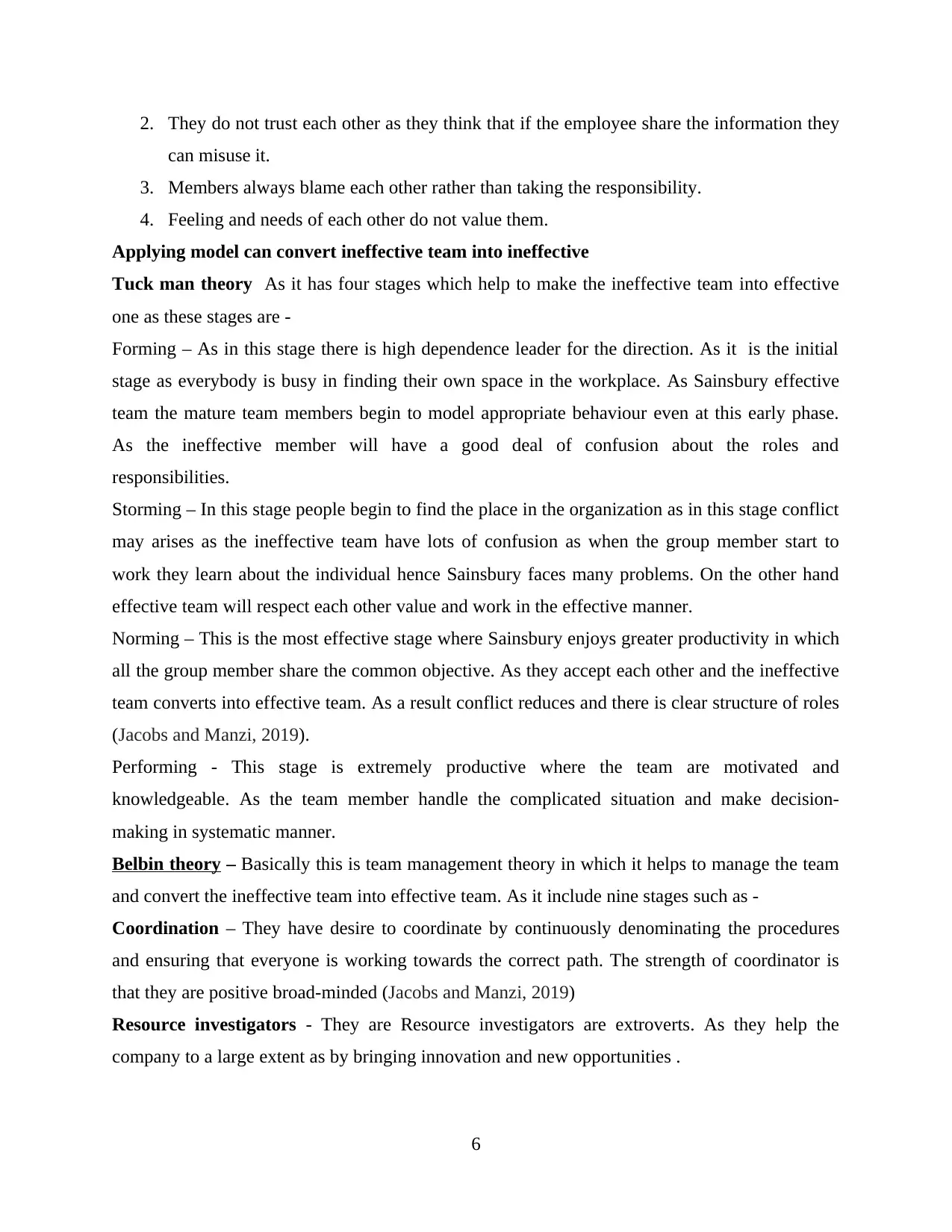
2. They do not trust each other as they think that if the employee share the information they
can misuse it.
3. Members always blame each other rather than taking the responsibility.
4. Feeling and needs of each other do not value them.
Applying model can convert ineffective team into ineffective
Tuck man theory As it has four stages which help to make the ineffective team into effective
one as these stages are -
Forming – As in this stage there is high dependence leader for the direction. As it is the initial
stage as everybody is busy in finding their own space in the workplace. As Sainsbury effective
team the mature team members begin to model appropriate behaviour even at this early phase.
As the ineffective member will have a good deal of confusion about the roles and
responsibilities.
Storming – In this stage people begin to find the place in the organization as in this stage conflict
may arises as the ineffective team have lots of confusion as when the group member start to
work they learn about the individual hence Sainsbury faces many problems. On the other hand
effective team will respect each other value and work in the effective manner.
Norming – This is the most effective stage where Sainsbury enjoys greater productivity in which
all the group member share the common objective. As they accept each other and the ineffective
team converts into effective team. As a result conflict reduces and there is clear structure of roles
(Jacobs and Manzi, 2019).
Performing - This stage is extremely productive where the team are motivated and
knowledgeable. As the team member handle the complicated situation and make decision-
making in systematic manner.
Belbin theory – Basically this is team management theory in which it helps to manage the team
and convert the ineffective team into effective team. As it include nine stages such as -
Coordination – They have desire to coordinate by continuously denominating the procedures
and ensuring that everyone is working towards the correct path. The strength of coordinator is
that they are positive broad-minded (Jacobs and Manzi, 2019)
Resource investigators - They are Resource investigators are extroverts. As they help the
company to a large extent as by bringing innovation and new opportunities .
6
can misuse it.
3. Members always blame each other rather than taking the responsibility.
4. Feeling and needs of each other do not value them.
Applying model can convert ineffective team into ineffective
Tuck man theory As it has four stages which help to make the ineffective team into effective
one as these stages are -
Forming – As in this stage there is high dependence leader for the direction. As it is the initial
stage as everybody is busy in finding their own space in the workplace. As Sainsbury effective
team the mature team members begin to model appropriate behaviour even at this early phase.
As the ineffective member will have a good deal of confusion about the roles and
responsibilities.
Storming – In this stage people begin to find the place in the organization as in this stage conflict
may arises as the ineffective team have lots of confusion as when the group member start to
work they learn about the individual hence Sainsbury faces many problems. On the other hand
effective team will respect each other value and work in the effective manner.
Norming – This is the most effective stage where Sainsbury enjoys greater productivity in which
all the group member share the common objective. As they accept each other and the ineffective
team converts into effective team. As a result conflict reduces and there is clear structure of roles
(Jacobs and Manzi, 2019).
Performing - This stage is extremely productive where the team are motivated and
knowledgeable. As the team member handle the complicated situation and make decision-
making in systematic manner.
Belbin theory – Basically this is team management theory in which it helps to manage the team
and convert the ineffective team into effective team. As it include nine stages such as -
Coordination – They have desire to coordinate by continuously denominating the procedures
and ensuring that everyone is working towards the correct path. The strength of coordinator is
that they are positive broad-minded (Jacobs and Manzi, 2019)
Resource investigators - They are Resource investigators are extroverts. As they help the
company to a large extent as by bringing innovation and new opportunities .
6
⊘ This is a preview!⊘
Do you want full access?
Subscribe today to unlock all pages.

Trusted by 1+ million students worldwide
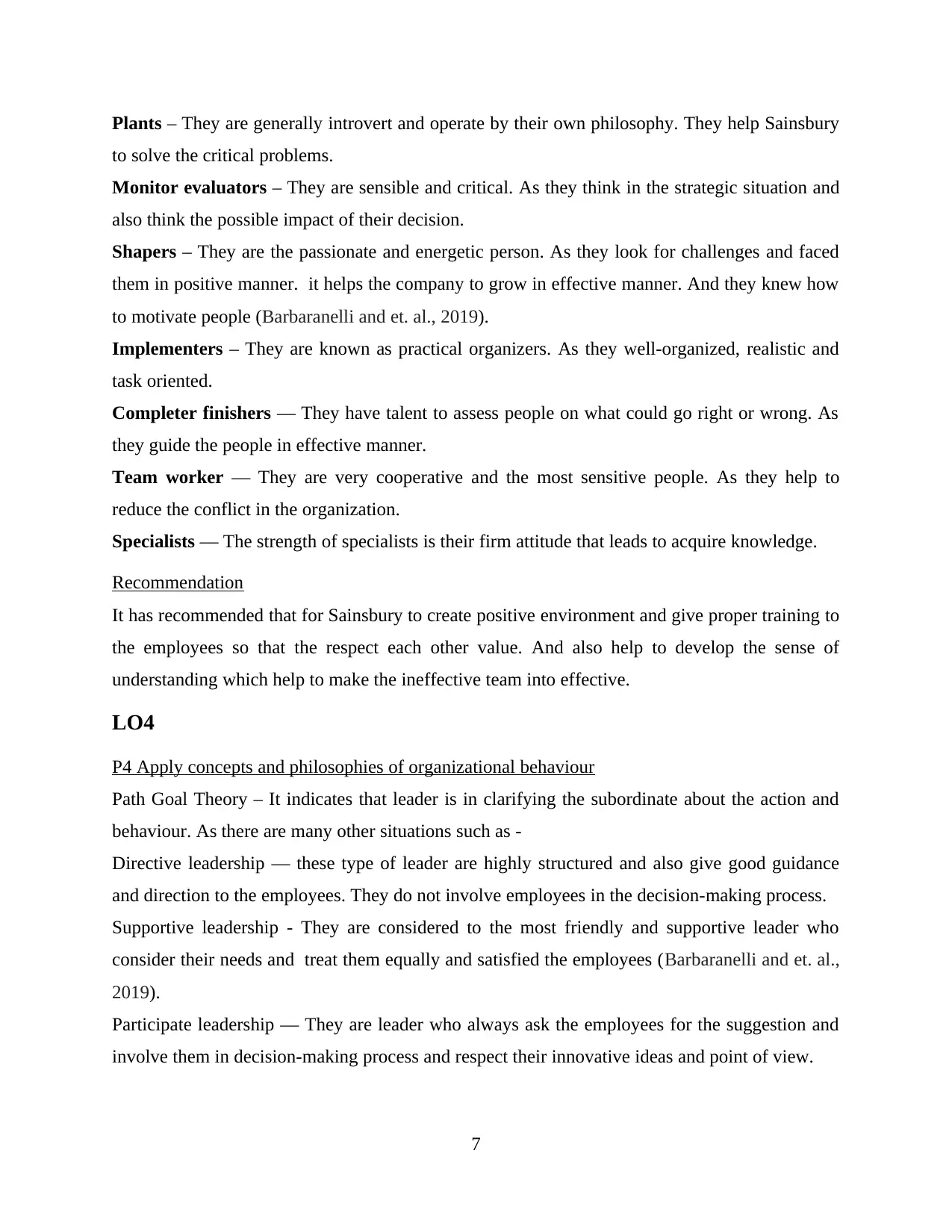
Plants – They are generally introvert and operate by their own philosophy. They help Sainsbury
to solve the critical problems.
Monitor evaluators – They are sensible and critical. As they think in the strategic situation and
also think the possible impact of their decision.
Shapers – They are the passionate and energetic person. As they look for challenges and faced
them in positive manner. it helps the company to grow in effective manner. And they knew how
to motivate people (Barbaranelli and et. al., 2019).
Implementers – They are known as practical organizers. As they well-organized, realistic and
task oriented.
Completer finishers — They have talent to assess people on what could go right or wrong. As
they guide the people in effective manner.
Team worker — They are very cooperative and the most sensitive people. As they help to
reduce the conflict in the organization.
Specialists — The strength of specialists is their firm attitude that leads to acquire knowledge.
Recommendation
It has recommended that for Sainsbury to create positive environment and give proper training to
the employees so that the respect each other value. And also help to develop the sense of
understanding which help to make the ineffective team into effective.
LO4
P4 Apply concepts and philosophies of organizational behaviour
Path Goal Theory – It indicates that leader is in clarifying the subordinate about the action and
behaviour. As there are many other situations such as -
Directive leadership — these type of leader are highly structured and also give good guidance
and direction to the employees. They do not involve employees in the decision-making process.
Supportive leadership - They are considered to the most friendly and supportive leader who
consider their needs and treat them equally and satisfied the employees (Barbaranelli and et. al.,
2019).
Participate leadership — They are leader who always ask the employees for the suggestion and
involve them in decision-making process and respect their innovative ideas and point of view.
7
to solve the critical problems.
Monitor evaluators – They are sensible and critical. As they think in the strategic situation and
also think the possible impact of their decision.
Shapers – They are the passionate and energetic person. As they look for challenges and faced
them in positive manner. it helps the company to grow in effective manner. And they knew how
to motivate people (Barbaranelli and et. al., 2019).
Implementers – They are known as practical organizers. As they well-organized, realistic and
task oriented.
Completer finishers — They have talent to assess people on what could go right or wrong. As
they guide the people in effective manner.
Team worker — They are very cooperative and the most sensitive people. As they help to
reduce the conflict in the organization.
Specialists — The strength of specialists is their firm attitude that leads to acquire knowledge.
Recommendation
It has recommended that for Sainsbury to create positive environment and give proper training to
the employees so that the respect each other value. And also help to develop the sense of
understanding which help to make the ineffective team into effective.
LO4
P4 Apply concepts and philosophies of organizational behaviour
Path Goal Theory – It indicates that leader is in clarifying the subordinate about the action and
behaviour. As there are many other situations such as -
Directive leadership — these type of leader are highly structured and also give good guidance
and direction to the employees. They do not involve employees in the decision-making process.
Supportive leadership - They are considered to the most friendly and supportive leader who
consider their needs and treat them equally and satisfied the employees (Barbaranelli and et. al.,
2019).
Participate leadership — They are leader who always ask the employees for the suggestion and
involve them in decision-making process and respect their innovative ideas and point of view.
7
Paraphrase This Document
Need a fresh take? Get an instant paraphrase of this document with our AI Paraphraser
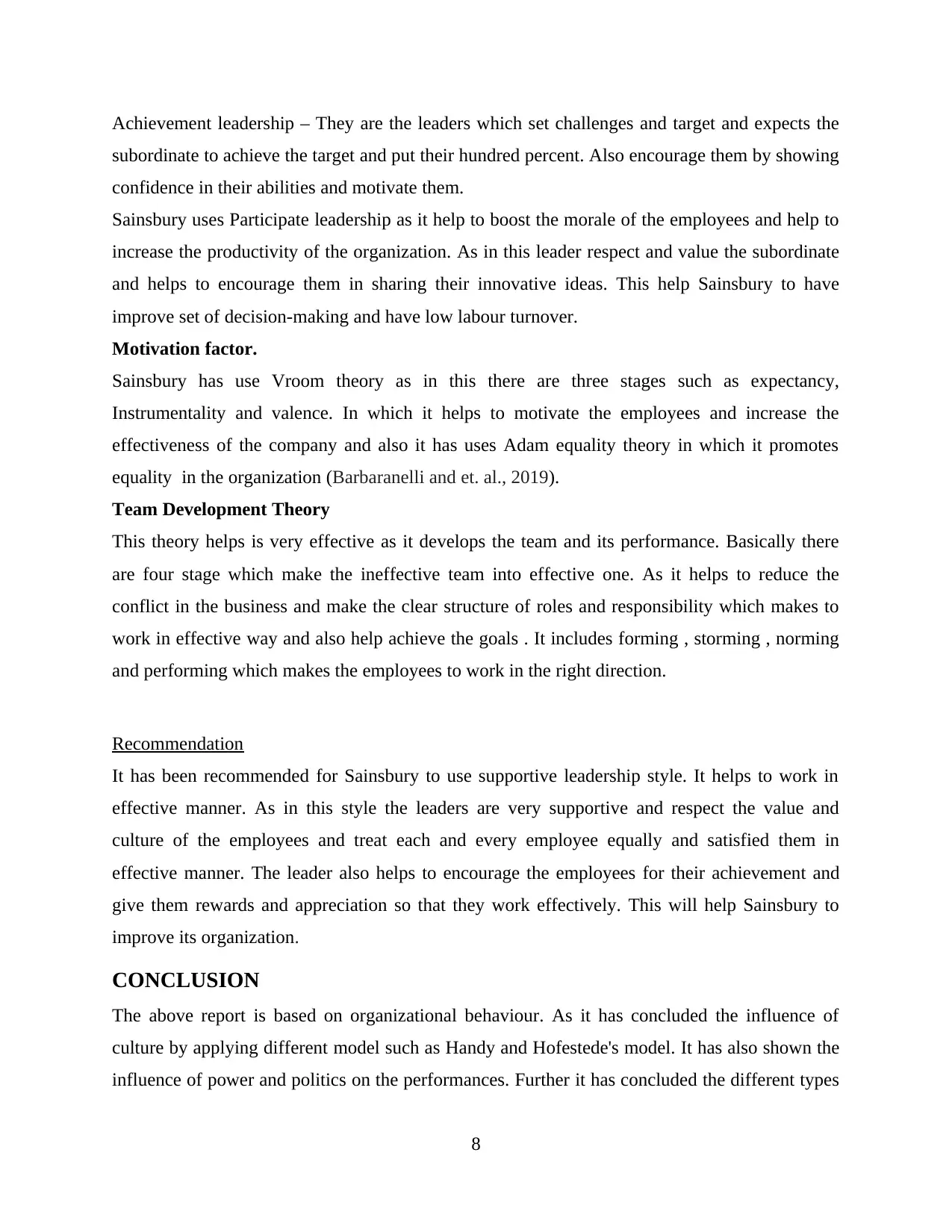
Achievement leadership – They are the leaders which set challenges and target and expects the
subordinate to achieve the target and put their hundred percent. Also encourage them by showing
confidence in their abilities and motivate them.
Sainsbury uses Participate leadership as it help to boost the morale of the employees and help to
increase the productivity of the organization. As in this leader respect and value the subordinate
and helps to encourage them in sharing their innovative ideas. This help Sainsbury to have
improve set of decision-making and have low labour turnover.
Motivation factor.
Sainsbury has use Vroom theory as in this there are three stages such as expectancy,
Instrumentality and valence. In which it helps to motivate the employees and increase the
effectiveness of the company and also it has uses Adam equality theory in which it promotes
equality in the organization (Barbaranelli and et. al., 2019).
Team Development Theory
This theory helps is very effective as it develops the team and its performance. Basically there
are four stage which make the ineffective team into effective one. As it helps to reduce the
conflict in the business and make the clear structure of roles and responsibility which makes to
work in effective way and also help achieve the goals . It includes forming , storming , norming
and performing which makes the employees to work in the right direction.
Recommendation
It has been recommended for Sainsbury to use supportive leadership style. It helps to work in
effective manner. As in this style the leaders are very supportive and respect the value and
culture of the employees and treat each and every employee equally and satisfied them in
effective manner. The leader also helps to encourage the employees for their achievement and
give them rewards and appreciation so that they work effectively. This will help Sainsbury to
improve its organization.
CONCLUSION
The above report is based on organizational behaviour. As it has concluded the influence of
culture by applying different model such as Handy and Hofestede's model. It has also shown the
influence of power and politics on the performances. Further it has concluded the different types
8
subordinate to achieve the target and put their hundred percent. Also encourage them by showing
confidence in their abilities and motivate them.
Sainsbury uses Participate leadership as it help to boost the morale of the employees and help to
increase the productivity of the organization. As in this leader respect and value the subordinate
and helps to encourage them in sharing their innovative ideas. This help Sainsbury to have
improve set of decision-making and have low labour turnover.
Motivation factor.
Sainsbury has use Vroom theory as in this there are three stages such as expectancy,
Instrumentality and valence. In which it helps to motivate the employees and increase the
effectiveness of the company and also it has uses Adam equality theory in which it promotes
equality in the organization (Barbaranelli and et. al., 2019).
Team Development Theory
This theory helps is very effective as it develops the team and its performance. Basically there
are four stage which make the ineffective team into effective one. As it helps to reduce the
conflict in the business and make the clear structure of roles and responsibility which makes to
work in effective way and also help achieve the goals . It includes forming , storming , norming
and performing which makes the employees to work in the right direction.
Recommendation
It has been recommended for Sainsbury to use supportive leadership style. It helps to work in
effective manner. As in this style the leaders are very supportive and respect the value and
culture of the employees and treat each and every employee equally and satisfied them in
effective manner. The leader also helps to encourage the employees for their achievement and
give them rewards and appreciation so that they work effectively. This will help Sainsbury to
improve its organization.
CONCLUSION
The above report is based on organizational behaviour. As it has concluded the influence of
culture by applying different model such as Handy and Hofestede's model. It has also shown the
influence of power and politics on the performances. Further it has concluded the different types
8
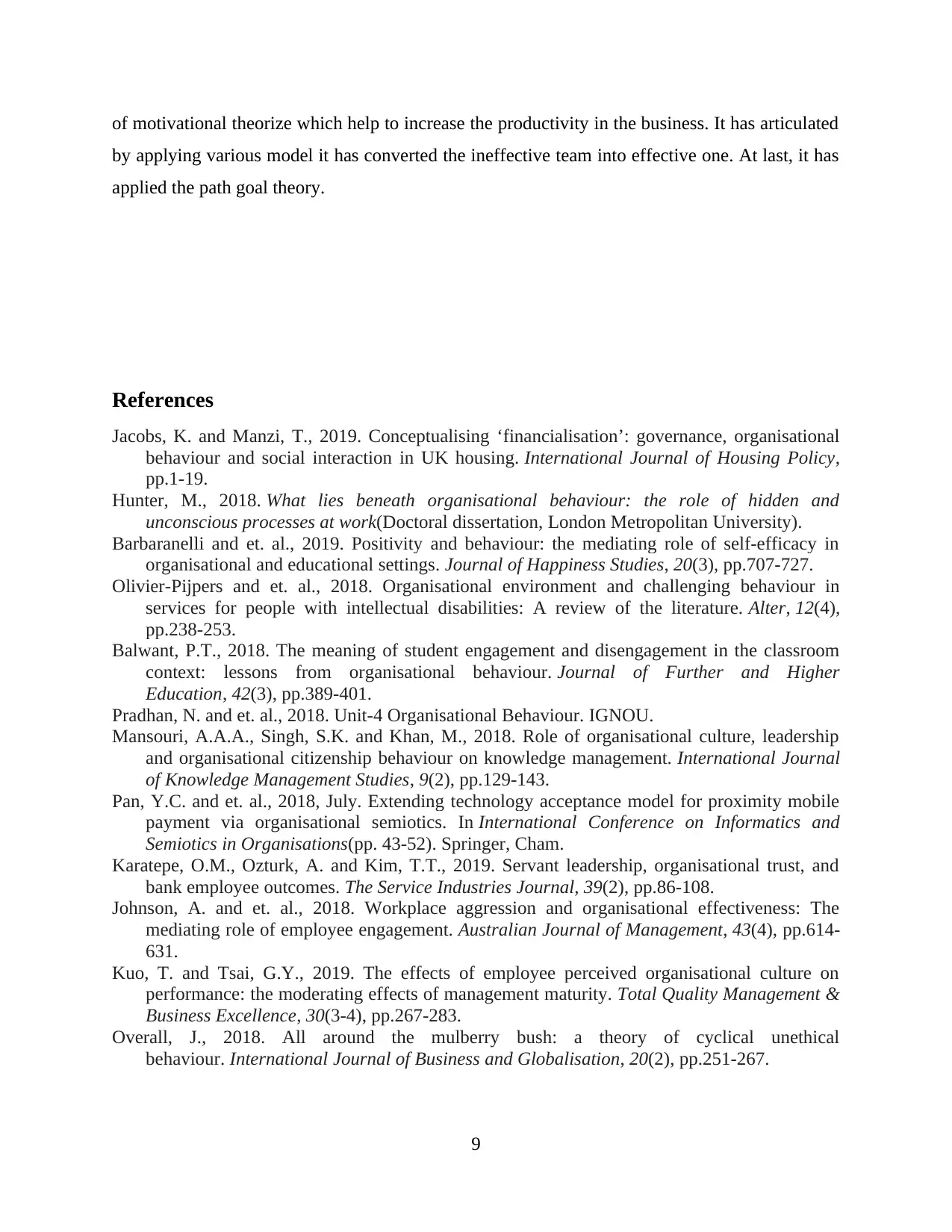
of motivational theorize which help to increase the productivity in the business. It has articulated
by applying various model it has converted the ineffective team into effective one. At last, it has
applied the path goal theory.
References
Jacobs, K. and Manzi, T., 2019. Conceptualising ‘financialisation’: governance, organisational
behaviour and social interaction in UK housing. International Journal of Housing Policy,
pp.1-19.
Hunter, M., 2018. What lies beneath organisational behaviour: the role of hidden and
unconscious processes at work(Doctoral dissertation, London Metropolitan University).
Barbaranelli and et. al., 2019. Positivity and behaviour: the mediating role of self-efficacy in
organisational and educational settings. Journal of Happiness Studies, 20(3), pp.707-727.
Olivier-Pijpers and et. al., 2018. Organisational environment and challenging behaviour in
services for people with intellectual disabilities: A review of the literature. Alter, 12(4),
pp.238-253.
Balwant, P.T., 2018. The meaning of student engagement and disengagement in the classroom
context: lessons from organisational behaviour. Journal of Further and Higher
Education, 42(3), pp.389-401.
Pradhan, N. and et. al., 2018. Unit-4 Organisational Behaviour. IGNOU.
Mansouri, A.A.A., Singh, S.K. and Khan, M., 2018. Role of organisational culture, leadership
and organisational citizenship behaviour on knowledge management. International Journal
of Knowledge Management Studies, 9(2), pp.129-143.
Pan, Y.C. and et. al., 2018, July. Extending technology acceptance model for proximity mobile
payment via organisational semiotics. In International Conference on Informatics and
Semiotics in Organisations(pp. 43-52). Springer, Cham.
Karatepe, O.M., Ozturk, A. and Kim, T.T., 2019. Servant leadership, organisational trust, and
bank employee outcomes. The Service Industries Journal, 39(2), pp.86-108.
Johnson, A. and et. al., 2018. Workplace aggression and organisational effectiveness: The
mediating role of employee engagement. Australian Journal of Management, 43(4), pp.614-
631.
Kuo, T. and Tsai, G.Y., 2019. The effects of employee perceived organisational culture on
performance: the moderating effects of management maturity. Total Quality Management &
Business Excellence, 30(3-4), pp.267-283.
Overall, J., 2018. All around the mulberry bush: a theory of cyclical unethical
behaviour. International Journal of Business and Globalisation, 20(2), pp.251-267.
9
by applying various model it has converted the ineffective team into effective one. At last, it has
applied the path goal theory.
References
Jacobs, K. and Manzi, T., 2019. Conceptualising ‘financialisation’: governance, organisational
behaviour and social interaction in UK housing. International Journal of Housing Policy,
pp.1-19.
Hunter, M., 2018. What lies beneath organisational behaviour: the role of hidden and
unconscious processes at work(Doctoral dissertation, London Metropolitan University).
Barbaranelli and et. al., 2019. Positivity and behaviour: the mediating role of self-efficacy in
organisational and educational settings. Journal of Happiness Studies, 20(3), pp.707-727.
Olivier-Pijpers and et. al., 2018. Organisational environment and challenging behaviour in
services for people with intellectual disabilities: A review of the literature. Alter, 12(4),
pp.238-253.
Balwant, P.T., 2018. The meaning of student engagement and disengagement in the classroom
context: lessons from organisational behaviour. Journal of Further and Higher
Education, 42(3), pp.389-401.
Pradhan, N. and et. al., 2018. Unit-4 Organisational Behaviour. IGNOU.
Mansouri, A.A.A., Singh, S.K. and Khan, M., 2018. Role of organisational culture, leadership
and organisational citizenship behaviour on knowledge management. International Journal
of Knowledge Management Studies, 9(2), pp.129-143.
Pan, Y.C. and et. al., 2018, July. Extending technology acceptance model for proximity mobile
payment via organisational semiotics. In International Conference on Informatics and
Semiotics in Organisations(pp. 43-52). Springer, Cham.
Karatepe, O.M., Ozturk, A. and Kim, T.T., 2019. Servant leadership, organisational trust, and
bank employee outcomes. The Service Industries Journal, 39(2), pp.86-108.
Johnson, A. and et. al., 2018. Workplace aggression and organisational effectiveness: The
mediating role of employee engagement. Australian Journal of Management, 43(4), pp.614-
631.
Kuo, T. and Tsai, G.Y., 2019. The effects of employee perceived organisational culture on
performance: the moderating effects of management maturity. Total Quality Management &
Business Excellence, 30(3-4), pp.267-283.
Overall, J., 2018. All around the mulberry bush: a theory of cyclical unethical
behaviour. International Journal of Business and Globalisation, 20(2), pp.251-267.
9
⊘ This is a preview!⊘
Do you want full access?
Subscribe today to unlock all pages.

Trusted by 1+ million students worldwide
1 out of 12
Related Documents
Your All-in-One AI-Powered Toolkit for Academic Success.
+13062052269
info@desklib.com
Available 24*7 on WhatsApp / Email
![[object Object]](/_next/static/media/star-bottom.7253800d.svg)
Unlock your academic potential
Copyright © 2020–2025 A2Z Services. All Rights Reserved. Developed and managed by ZUCOL.





